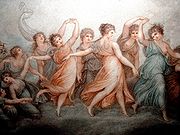
The Hours (engraving)
Encyclopedia

Stippling
Stippling is the creation of a pattern simulating varying degrees of solidity or shading by using small dots. Such a pattern may occur in nature and these effects are frequently emulated by artists.-Art:...
engraving
Engraving
Engraving is the practice of incising a design on to a hard, usually flat surface, by cutting grooves into it. The result may be a decorated object in itself, as when silver, gold, steel, or glass are engraved, or may provide an intaglio printing plate, of copper or another metal, for printing...
by a master of the technique, Francesco Bartolozzi
Francesco Bartolozzi
Francesco Bartolozzi was an Italian engraver, whose most productive period was spent in London.He was born in Florence...
(1725-1815), published on April 4, 1788, from the print shop of Thomas Macklin
Thomas Macklin
Thomas Macklin was a British 18th-century printseller and picture dealer.Macklin married Hannah Kenting in 1777 and started a printselling business in London in 1779. His first year, his sold 7,000 copies of a print of Rear Admiral Richard Kempenfelt...
, at No. 30 Fleet Street
Fleet Street
Fleet Street is a street in central London, United Kingdom, named after the River Fleet, a stream that now flows underground. It was the home of the British press until the 1980s...
, London
London
London is the capital city of :England and the :United Kingdom, the largest metropolitan area in the United Kingdom, and the largest urban zone in the European Union by most measures. Located on the River Thames, London has been a major settlement for two millennia, its history going back to its...
. The print is based upon a painting by Maria Cosway
Maria Cosway
Maria Cosway was an Anglo-Italian artist, who exhibited at the Royal Academy of Arts in London. She also worked in France, where she cultivated a large circle of friends and clients, and later in Italy. She commissioned the first portrait of Napoleon to be seen in England...
(1760-1838). The dancing hours
Horae
In Greek mythology the Horae or Hours were the goddesses of the seasons and the natural portions of time. They were originally the personifications of nature in its different seasonal aspects, but in later times they were regarded as goddessess of order in general and natural justice...
, or nymphs of Greek mythology, were a pictorial representation of the poem "Ode on the Spring" by British poet Thomas Gray
Thomas Gray
Thomas Gray was a poet, letter-writer, classical scholar and professor at Cambridge University.-Early life and education:...
(1716-1771). The poem begins:
"Lo! where the rosy-bosomed Hours,
Fair Venus' train, appear,
Disclose the long-expecting flowers,
And wake the purple year!
The Attic warbler pours her throat,
Responsive to the cuckoo's note,
The untaught harmony of spring:
While, whisp'ring pleasure as they fly,
Cool Zephyrs thro' the clear blue sky
Their gathered fragrance fling."
Maria Cosway sent a copy of the engraving to Jacques-Louis David
Jacques-Louis David
Jacques-Louis David was an influential French painter in the Neoclassical style, considered to be the preeminent painter of the era...
(1748-1825), a highly influential French painter, who stated, "on ne peut pas faire une poesie plus ingenieuse et plus naturelle." ("One couldn't make poetry more ingenious and more natural.")
The Stippling Technique
The stippling technique involved the etchingEtching
Etching is the process of using strong acid or mordant to cut into the unprotected parts of a metal surface to create a design in intaglio in the metal...
, usually on a copper plate, of stipple dots to form an image. The process was tedious; many thousands of these dots were required to form an image of this quality. After the copper plate was etched, it was then used to make a number of prints by the usual intaglio
Intaglio (printmaking)
Intaglio is a family of printmaking techniques in which the image is incised into a surface, known as the matrix or plate, and the incised line or area holds the ink. Normally, copper or zinc plates are used as a surface, and the incisions are created by etching, engraving, drypoint, aquatint or...
method. The number depended upon how well the plate held up during the printing process, which abraded the plate slightly with each use. The earlier prints, therefore, were of better quality than the later ones. At some point the plate became so abraded that it was no longer usable.
The printing and coloring (hand washing) of each engraving was difficult, and required the hand of an artist. For that reason, many of these old original prints were inked by the master himself.
Stippling is used to excellent effect in representing transparent materials in the filmy gowns and gossamer wings of the nymphs.

